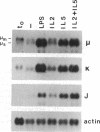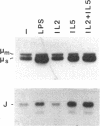Abstract
Two functional polymeric forms of IgM can be produced by antibody-secreting B cells. Hexameric IgM lacks detectable J (joining) chain and activates complement 17-fold better than pentameric IgM, which usually contains one J chain per pentamer. Using the inducible B-cell lymphoma CH12, we determined if the synthesis of a particular polymeric form of IgM is a fixed property of B cells or can be altered. Lipopolysaccharide (LPS)-stimulated CH12 cells produced mixtures of IgM hexamers and pentamers, resulting in antibody with high complement-fixing activity. In contrast, interleukin-5-stimulated CH12 cells secreted predominantly pentameric IgM, with a correspondingly lower lytic activity. Differences in lytic activity were due only to the amount of hexameric IgM in the secreted antibody. Interleukin 5 stimulated higher production of J chain RNA and protein than LPS, while LPS induced the highest levels of the secretory form of mu protein. The amount of hexameric IgM secreted was therefore inversely proportional to the level of intracellular J chain protein in the responding B cells. We conclude that the biologic function of IgM produced by B cells differs depending on how they are stimulated and that this difference may be regulated by the relative availabilities of J chain and secretory mu proteins during IgM polymerization.
Full text
PDF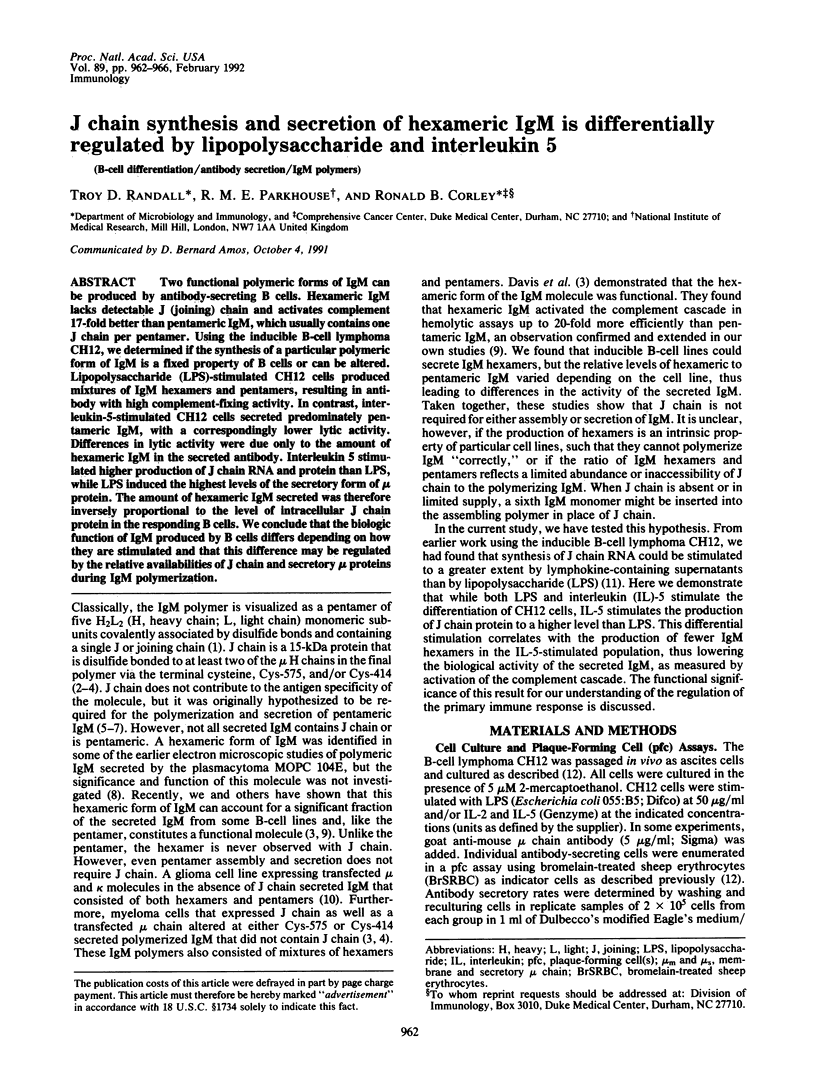


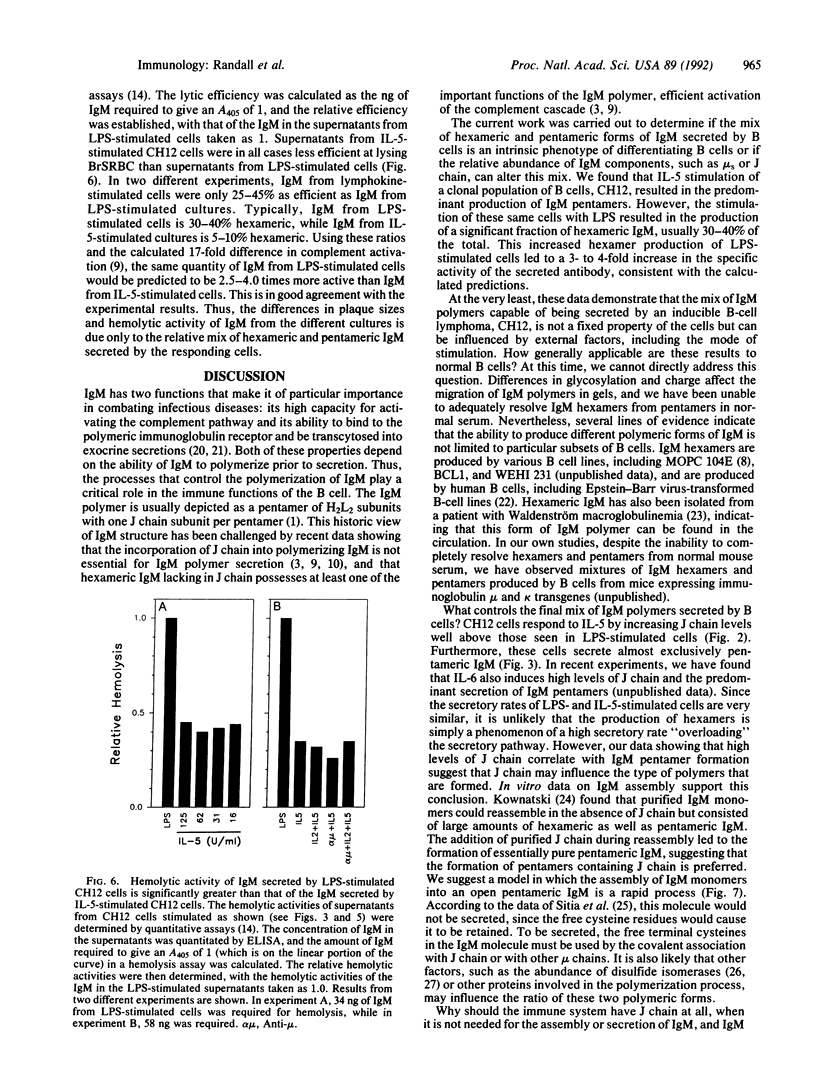
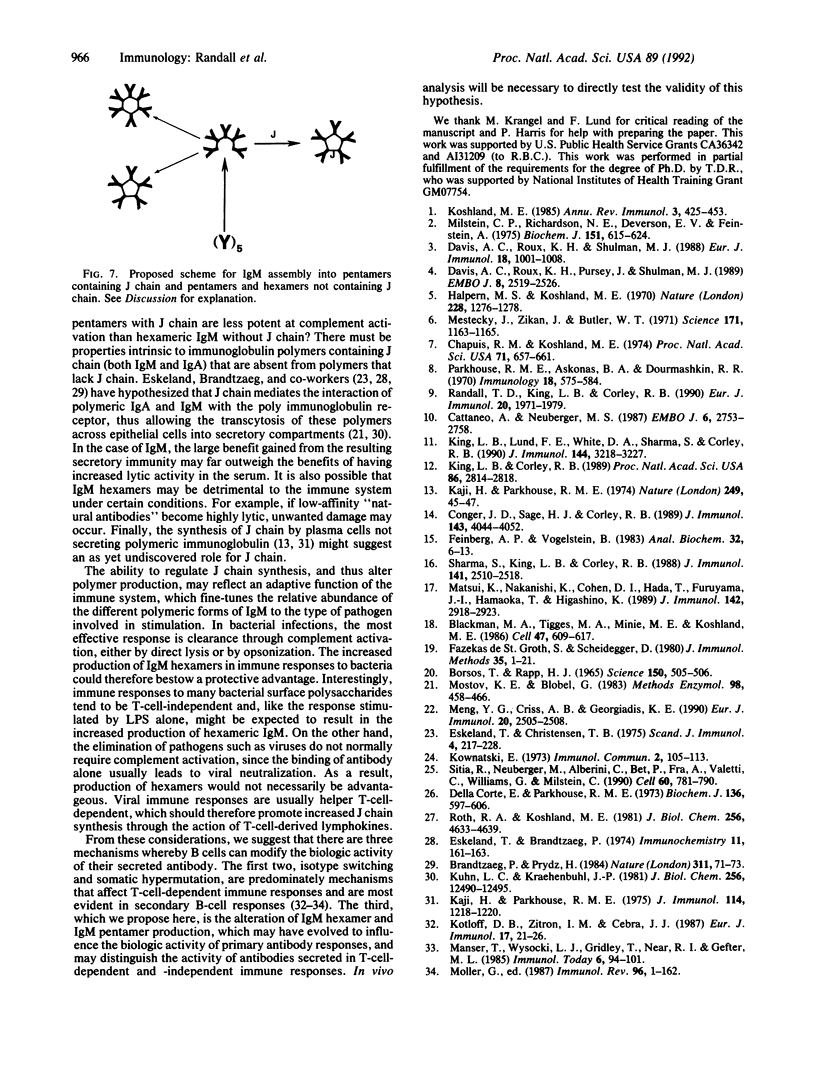
Images in this article
Selected References
These references are in PubMed. This may not be the complete list of references from this article.
- Blackman M. A., Tigges M. A., Minie M. E., Koshland M. E. A model system for peptide hormone action in differentiation: interleukin 2 induces a B lymphoma to transcribe the J chain gene. Cell. 1986 Nov 21;47(4):609–617. doi: 10.1016/0092-8674(86)90625-2. [DOI] [PubMed] [Google Scholar]
- Borsos T., Rapp H. J. Complement fixation on cell surfaces by 19S and 7S antibodies. Science. 1965 Oct 22;150(3695):505–506. doi: 10.1126/science.150.3695.505. [DOI] [PubMed] [Google Scholar]
- Brandtzaeg P., Prydz H. Direct evidence for an integrated function of J chain and secretory component in epithelial transport of immunoglobulins. Nature. 1984 Sep 6;311(5981):71–73. doi: 10.1038/311071a0. [DOI] [PubMed] [Google Scholar]
- Cattaneo A., Neuberger M. S. Polymeric immunoglobulin M is secreted by transfectants of non-lymphoid cells in the absence of immunoglobulin J chain. EMBO J. 1987 Sep;6(9):2753–2758. doi: 10.1002/j.1460-2075.1987.tb02569.x. [DOI] [PMC free article] [PubMed] [Google Scholar]
- Chapuis R. M., Koshland M. E. Mechanism of IgM polymerization. Proc Natl Acad Sci U S A. 1974 Mar;71(3):657–661. doi: 10.1073/pnas.71.3.657. [DOI] [PMC free article] [PubMed] [Google Scholar]
- Conger J. D., Sage H. J., Corley R. B. Diversity in the available repertoire of murine antibodies reactive with bromelain-treated isologous erythrocytes. J Immunol. 1989 Dec 15;143(12):4044–4052. [PubMed] [Google Scholar]
- Davis A. C., Roux K. H., Pursey J., Shulman M. J. Intermolecular disulfide bonding in IgM: effects of replacing cysteine residues in the mu heavy chain. EMBO J. 1989 Sep;8(9):2519–2526. doi: 10.1002/j.1460-2075.1989.tb08389.x. [DOI] [PMC free article] [PubMed] [Google Scholar]
- Davis A. C., Roux K. H., Shulman M. J. On the structure of polymeric IgM. Eur J Immunol. 1988 Jul;18(7):1001–1008. doi: 10.1002/eji.1830180705. [DOI] [PubMed] [Google Scholar]
- Della Corte E., Parkhouse R. M. Biosynthesis of immunoglobulin A (IgA) and immunoglobulin M (IgM). Requirement for J chain and a disulphide-exchanging enzyme for polymerization. Biochem J. 1973 Nov;136(3):597–606. doi: 10.1042/bj1360597. [DOI] [PMC free article] [PubMed] [Google Scholar]
- Eskeland T., Brandtzaeg P. Does J chain mediate the combination of 19S IgM and dimeric IgA with the secretory component rather than being necessary for their polymerization? Immunochemistry. 1974 Mar;11(3):161–163. doi: 10.1016/0019-2791(74)90214-6. [DOI] [PubMed] [Google Scholar]
- Eskeland T., Christensen T. B. IgM molecules with and without J chain in serum and after purification, studied by ultracentrifugation, electrophoresis, and electron microscopy. Scand J Immunol. 1975;4(3):217–228. doi: 10.1111/j.1365-3083.1975.tb02620.x. [DOI] [PubMed] [Google Scholar]
- Feinberg A. P., Vogelstein B. A technique for radiolabeling DNA restriction endonuclease fragments to high specific activity. Anal Biochem. 1983 Jul 1;132(1):6–13. doi: 10.1016/0003-2697(83)90418-9. [DOI] [PubMed] [Google Scholar]
- Halpern M. S., Koshland M. E. Noval subunit in secretory IgA. Nature. 1970 Dec 26;228(5278):1276–1278. doi: 10.1038/2281276a0. [DOI] [PubMed] [Google Scholar]
- Kaji H., Parkhouse M. E. Control of J chain biosynthesis in relation to heavy and light chain synthesis, polymerization and secretion. J Immunol. 1975 Apr;114(4):1218–1220. [PubMed] [Google Scholar]
- Kaji H., Parkhouse R. M. Intracellular J chain in mouse plasmacytomas secreting IgA, IgM and IgG. Nature. 1974 May 3;249(452):45–47. doi: 10.1038/249045a0. [DOI] [PubMed] [Google Scholar]
- King L. B., Corley R. B. Characterization of a presecretory phase in B-cell differentiation. Proc Natl Acad Sci U S A. 1989 Apr;86(8):2814–2818. doi: 10.1073/pnas.86.8.2814. [DOI] [PMC free article] [PubMed] [Google Scholar]
- King L. B., Lund F. E., White D. A., Sharma S., Corley R. B. Molecular events in B lymphocyte differentiation. Inducible expression of the endogenous mouse mammary tumor proviral gene, Mtv-9. J Immunol. 1990 Apr 15;144(8):3218–3227. [PubMed] [Google Scholar]
- Koshland M. E. The coming of age of the immunoglobulin J chain. Annu Rev Immunol. 1985;3:425–453. doi: 10.1146/annurev.iy.03.040185.002233. [DOI] [PubMed] [Google Scholar]
- Kotloff D. B., Zitron I. M., Cebra J. J. Carrier-specific T cells sufficient for the expression of multiple isotypes in B cell cultures. Eur J Immunol. 1987 Jan;17(1):21–26. doi: 10.1002/eji.1830170105. [DOI] [PubMed] [Google Scholar]
- Kownatzki E. Reassociation of IgM subunits in the presence and absence of J chain. Immunol Commun. 1973;2(1):105–113. doi: 10.3109/08820137309022886. [DOI] [PubMed] [Google Scholar]
- Kühn L. C., Kraehenbuhl J. P. The membrane receptor for polymeric immunoglobulin is structurally related to secretory component. Isolation and characterization of membrane secretory component from rabbit liver and mammary gland. J Biol Chem. 1981 Dec 10;256(23):12490–12495. [PubMed] [Google Scholar]
- Matsui K., Nakanishi K., Cohen D. I., Hada T., Furuyama J., Hamaoka T., Higashino K. B cell response pathways regulated by IL-5 and IL-2. Secretory microH chain-mRNA and J chain mRNA expression are separately controlled events. J Immunol. 1989 Apr 15;142(8):2918–2923. [PubMed] [Google Scholar]
- Meng Y. G., Criss A. B., Georgiadis K. E. J chain deficiency in human IgM monoclonal antibodies produced by Epstein-Barr virus-transformed B lymphocytes. Eur J Immunol. 1990 Nov;20(11):2505–2508. doi: 10.1002/eji.1830201122. [DOI] [PubMed] [Google Scholar]
- Mestecky J., Zikan J., Butler W. T. Immunoglobulin M and secretory immunoglobulin A: presence of a common polypeptide chain different from light chains. Science. 1971 Mar 19;171(3976):1163–1165. doi: 10.1126/science.171.3976.1163. [DOI] [PubMed] [Google Scholar]
- Milstein C. P., Richardson N. E., Dieverson E. V., Feinstein A. Interchain disulphide bridges of mouse immunoglobulin M. Biochem J. 1975 Dec;151(3):615–624. doi: 10.1042/bj1510615. [DOI] [PMC free article] [PubMed] [Google Scholar]
- Mostov K. E., Blobel G. Biosynthesis, processing, and function of secretory component. Methods Enzymol. 1983;98:458–466. doi: 10.1016/0076-6879(83)98173-9. [DOI] [PubMed] [Google Scholar]
- Parkhouse R. M., Askonas B. A., Dourmashkin R. R. Electron microscopic studies of mouse immunoglobulin M; structure and reconstitution following reduction. Immunology. 1970 Apr;18(4):575–584. [PMC free article] [PubMed] [Google Scholar]
- Randall T. D., King L. B., Corley R. B. The biological effects of IgM hexamer formation. Eur J Immunol. 1990 Sep;20(9):1971–1979. doi: 10.1002/eji.1830200915. [DOI] [PubMed] [Google Scholar]
- Roth R. A., Koshland M. E. Identification of a lymphocyte enzyme that catalyzes pentamer immunoglobulin M assembly. J Biol Chem. 1981 May 10;256(9):4633–4639. [PubMed] [Google Scholar]
- Sharma S., King L. B., Corley R. B. Molecular events during B lymphocyte differentiation. Induction of endogenous mouse mammary tumor proviral envelope transcripts after B cell stimulation. J Immunol. 1988 Oct 1;141(7):2510–2518. [PubMed] [Google Scholar]
- Sitia R., Neuberger M., Alberini C., Bet P., Fra A., Valetti C., Williams G., Milstein C. Developmental regulation of IgM secretion: the role of the carboxy-terminal cysteine. Cell. 1990 Mar 9;60(5):781–790. doi: 10.1016/0092-8674(90)90092-s. [DOI] [PubMed] [Google Scholar]



